Reader profile: Tim
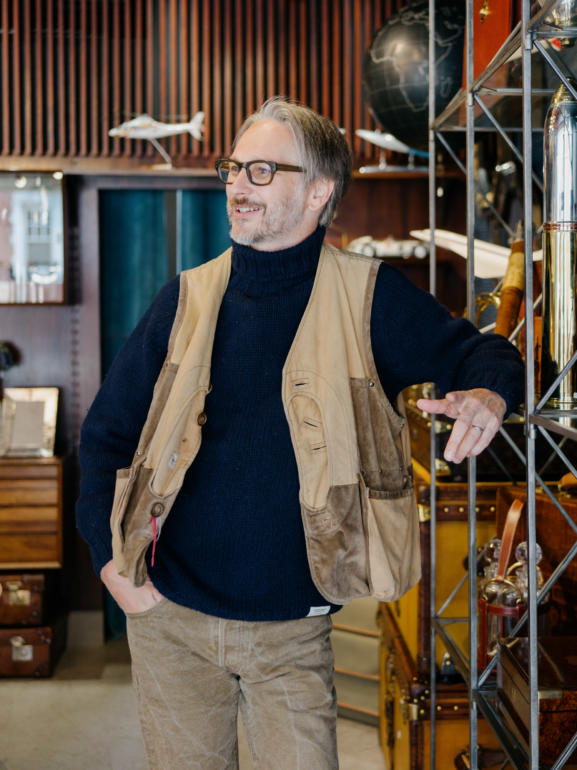
Tim owns an antique luggage and travel accessories shop, and spends a lot of his time either in the store or on the road sourcing. His clothes are eminently practical, but they also speak of a love of old things, including all second-hand clothing.
I’ve liked the distinctive way Tim dresses for a while, but it wasn’t until we talked about his wardrobe that I realised quite how much is second hand, and frequently refurbished.
Perhaps more surprising, Tim himself didn’t quite appreciate how much his attitude to clothing had in common with the objects he collects and sells, until we starting talking about it. It was an enjoyable and a revealing conversation.
(Oh, and I know it's August - but all the clothes we loved were cold-weather ones... Consider this a piece of Autumn/Winter anticipation.)
Outfit 1: Semi-formal
Tim, I’m immediately getting a sense of things re-used and repaired, starting with that scarf. And of course a love of blue.
Right on both counts, Simon. Although actually the scarf probably counts double. It was made by Judy Augur, who creates clothes out of reclaimed materials in California. This one is her take on ‘boro’ material. But also since I’ve had it, the scarf has been attacked by moths, so it has had its own repairs.
And am I right that the down jacket has been repaired as well?
Yes, that’s harder to see, but it’s an example of a different type of reuse and repair - one by a corporate rather a craftsman.
The jacket is from Patagonia, and I’ve had it for years. Recently, it developed little holes in some of the panels, probably from being scraped against something. I contacted Patagonia, and they said I should send it to third-party repairers in the UK.
The repairer told me that they would try to match the colours of the panels, but it might not be the same. That was fine with me, and in fact when I got it back I thought it looked better than new - it had these little personal touches [see shot above].
How much did Patagonia charge for that?
It was free; they even covered the shipping there and back. I guess that kind of sustainable attitude is built into what they do, but it made me want to buy all my technical clothing from them.
Impressive, and I have to say I’d have the same reaction. Where are the other pieces from?
The shirt is from Nick Ashley, circa 1990. I picked it up on eBay. I think you could say his attitude to clothing has always centred around things that are practical, and only get better with age.
The bandana is vintage, from Tenue de Nimes in Amsterdam. And both the Alden boots and Rocky Mountain Featherbed gilet are from Marrkt, so second hand.
The gilet looks particularly good from being worn in.
Yes, those down gilets start very puffy, but damp down over time. This feels so good now. And of course you can see the nice ageing on the cord outside.
How much clothing do you buy second hand?
You know I never stopped to think about it, but I think over half. I certainly buy a lot from Marrkt - the daily drop emails can get pretty addictive. When it’s leading up to my birthday, my wife and children will try to look at that email as soon as it arrives - so they can buy something for me before I get my hands on it.
There’s another recommendation on repairs actually - the Alden boots were recently resoled by a place called Yorkshire Sole. They’re known for Red Wings, but did a great job on these Aldens as well - those original crepe soles never seem to last long. I did resole once with Alden in the past, but it wasn’t cheap, and Yorkshire Sole did a great job.
Outfit 2: Casual
This looks extremely practical. Where are you normally going with all these layers?
This is my standard attire for antique markets. I’ll often be there when they open, which could be 6am, and it’s all outside - so it can be very cold. These pieces also have lots of pockets, which is what I need on a day like that.
Is the coat a Nigel Cabourn ‘Everest’ parka? I haven’t seen one like that before
Yes it is, but I think it’s a German sample that never went into production. It still has the sample label in the pocket, with the swatches.
Rather than the normal Ventile on the outside, this is waxed Ventile I think, certainly a cotton, and then it has a wool lining. It’s incredibly warm, and actually breathes very well, which isn’t what you’d expect from wax.
Perhaps a lot of the wax has rubbed off over the years.
Yes you might be right. Then layered under that is a duck-canvas waistcoat, which probably dates from around 1990.
I bought it from the lovely shop Voyage on the Fulham Road, which was very fashionable back in the 1990s. God it was expensive, but they had some great things. I think they famously turned away Madonna because she didn’t have one of their VIP cards - you had to have one for admittance towards the end.
What are the strings hanging off the buttons?
Oh those are from the tickets for getting into Newark market. That’s an enormous one - they market it as the biggest one in Europe. I’ve been going for over 30 years, and that is an early start. Actually I used to sleep overnight in the car in order to be there early, but I don’t go quite that far anymore.
The waistcoat also has a little hook on the back, which the missus sewed on so I could hang my net there when I’m fishing. I use a very simple Japanese fly-fishing technique called Tenkara, so I only fish for trout really, and it involves very little tackle. I’m probably guilty of carrying too much tackle, but that’s the idea.
Where’s everything else from?
The rollneck is a replica Royal Navy submariner from Aero Leathers, the jeans are Oni Denim sulphur-dyed canvas from Son of a Stag, and the boots are Redwing with bespoke laces made by my daughter Martha.
It sounds like repairing and making skills run in the family.
Well, certainly with my daughter yes. She’s just finished her degree in fashion design and specialised in sustainable leather. But she makes all sorts of things. She made these laces, and she did the painting on the jeans in the next outfit.
Outfit 3: Formal
OK, this isn’t really formal. But this is what you would wear for being in the shop day to day, correct?
Yes, it’s normally denim and some kind of shirt. Wearing a suit wouldn’t really fit in with our relaxed attitude, but you also have to be a little smart to sell someone a Vuitton trunk costing thousands of pounds.
Do you think there are other parallels between your clothes and occupation? You value old things, like to repair them?
Yes you’re right. I certainly buy things in a similar way, and appreciate patina on something like that Cabourn parka in the same way I do on an old leather briefcase.
The business is very visual, and is about an immediate, instinctive reaction to something. It’s also indulgent to the extent that it just involves me buying things I like.
Do the pieces you buy from markets usually need repairing as well?
Yes they nearly always will do, and that’s where some of the cost comes in too - knowing the best craftsmen and the best ways to refurbish rather than simply selling them on.
I’m also a collector with clothes in the same way as antiques. Although I love buying second-hand clothing, I’ve never really got around to the other part of it, which is selling on ones you don’t wear.
So where do they all go?
Well we live in the countryside, which helps as far as space goes. And there’s a hanger-sized space that a lot of this lives in. It’s easier to justify when you’re a professional collector of other things!
Tell us about those jeans then.
They’re old Levi’s Vintage Clothing 511s, with patching and painting on the coin pocket by Martha. The boro patching was done over a hole, using materials which I believe she’d treated to give them the aged appearance. The tiger symbol was hand painted and matches her tattoo.
And how about everything else?
The linen DB is a garment-dyed blazer from LBM1911, the shirt is from Emmett and the bandana is from Kapital. The canvas sneakers are Penguin.
A lot of these clothes seem very tactile - not necessarily the same textures, but usually with something interesting in the texture.
You’re probably right, that does appeal to me. I think when you’re in the antiques trade a lot of things come down to feeling the objects, touching them and appreciating what they’re made of. How they have aged and will age. It’s very hands on.
In fact I went to Spitalfields antiques market this past Thursday, and picked up this little leather dice shaker at a stall. I was handling it, playing with it. The seller said I clearly liked its tactile nature, and it was true - it felt so good in the hand.
I’m the same with clothing. I’ll go to a market and have to pick up and handle every single piece of clothing on the rail. That probable comes from my father - he was in the rag trade, and I must have seen that from a very young age.
Thanks Tim, that was fascinating and enjoyable.
No problem Simon, I think I learnt a good bit about myself along the way too!
Photography: James Holborow


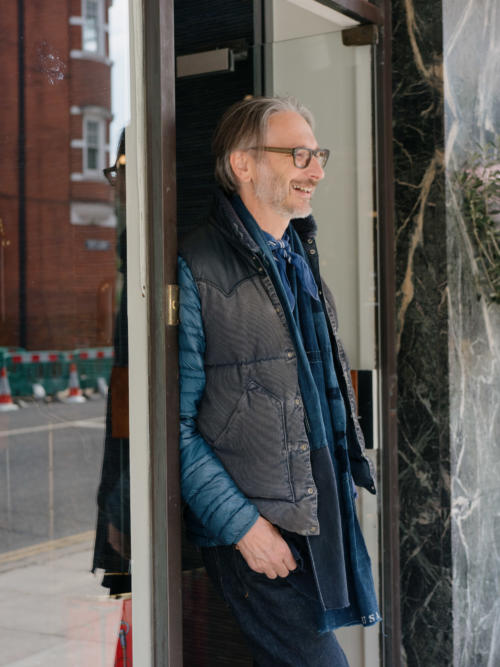
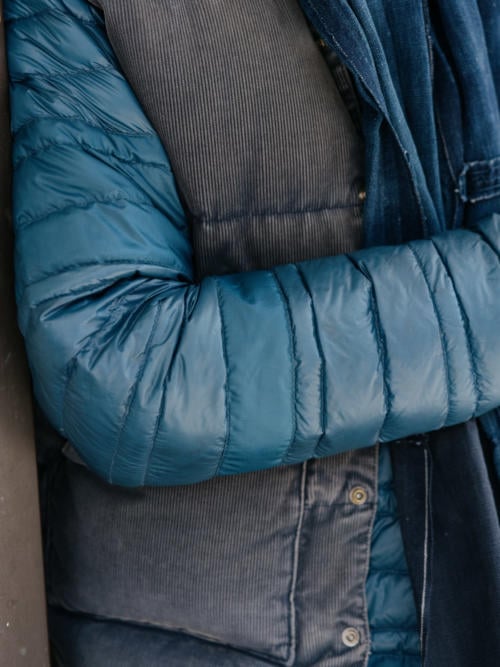
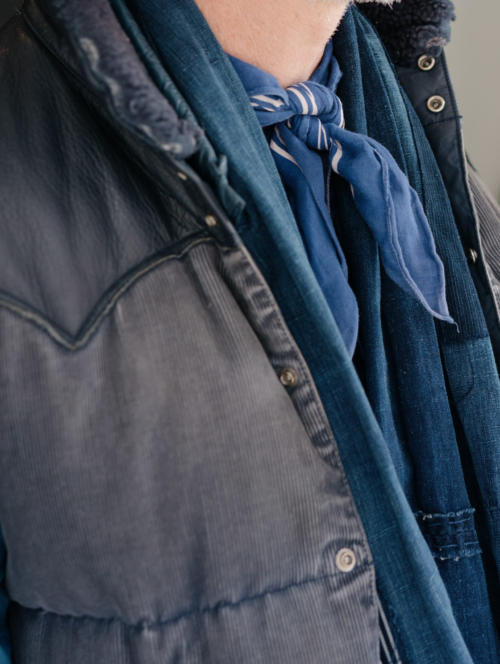
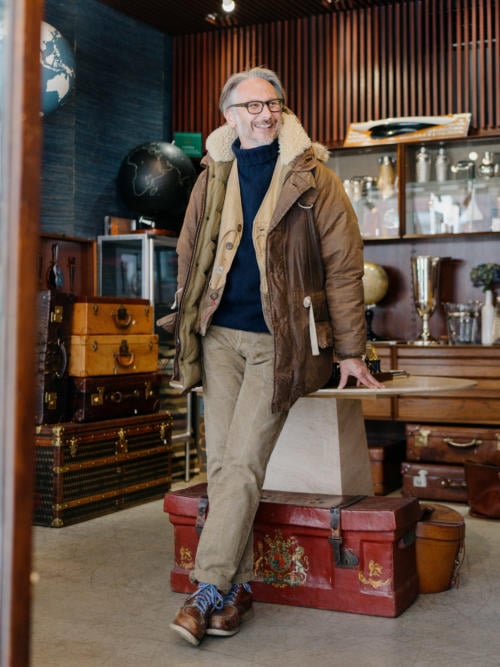
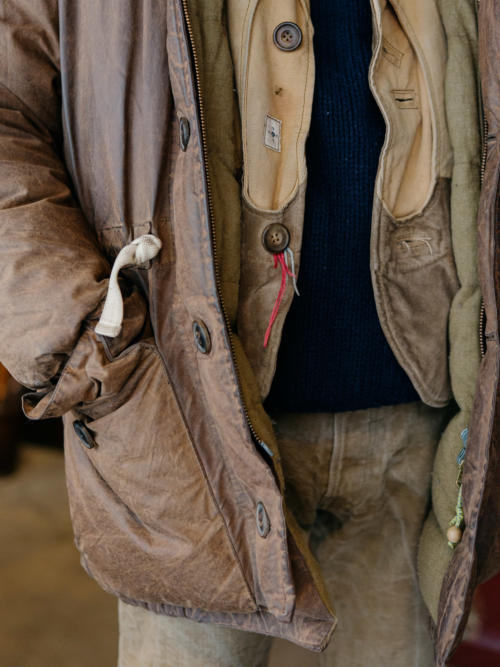
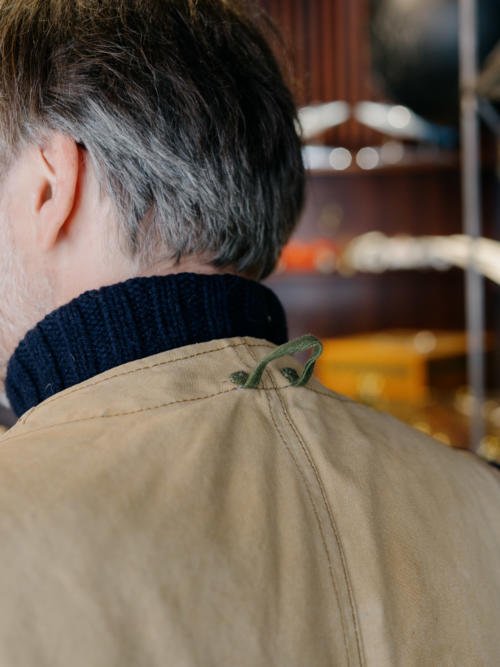
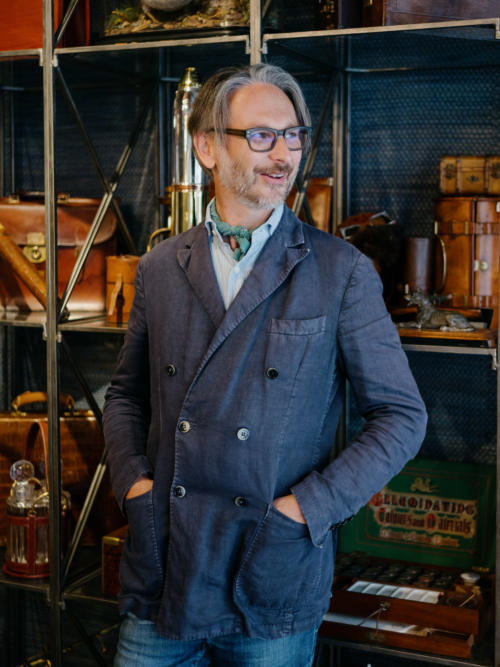
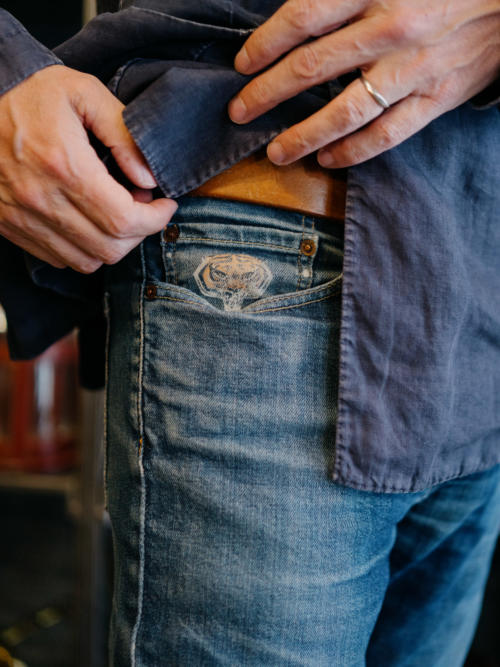
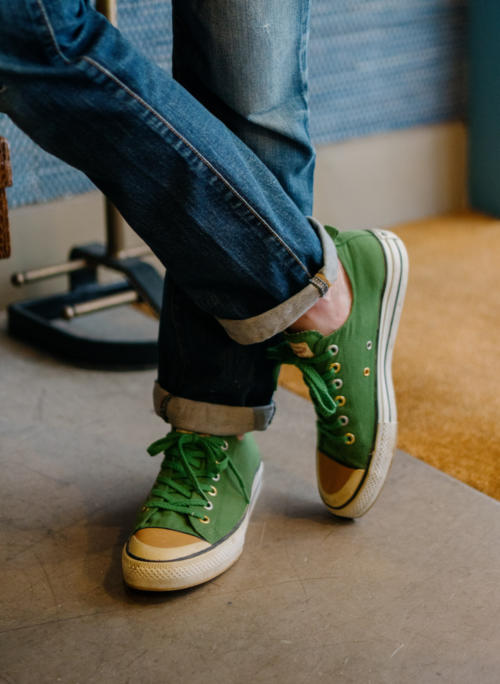
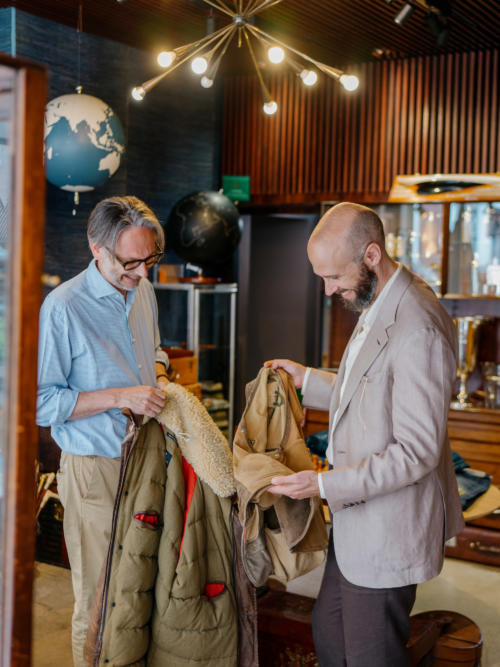
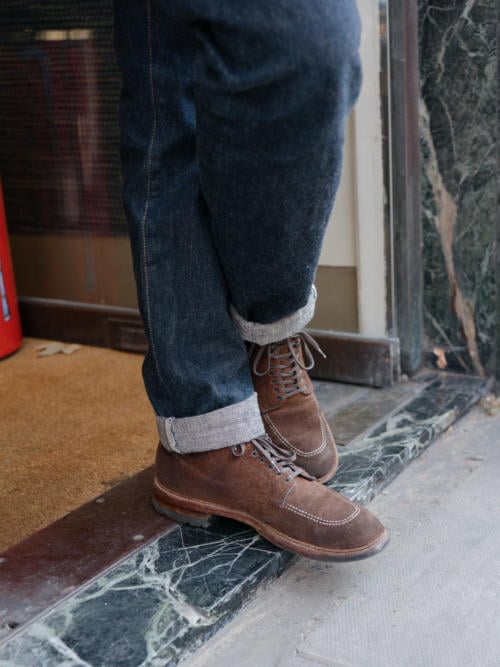
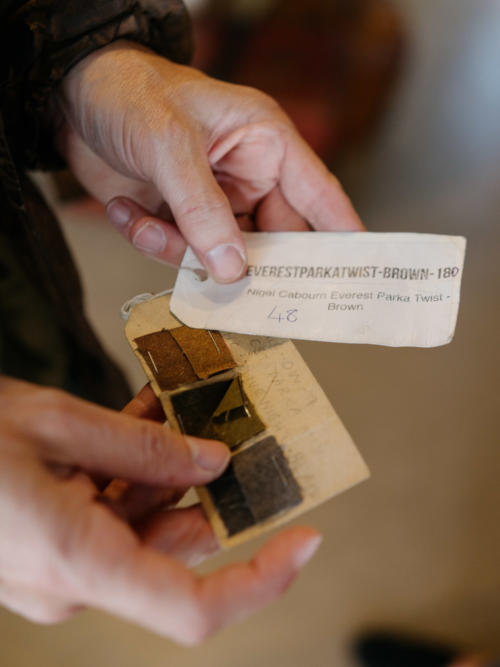
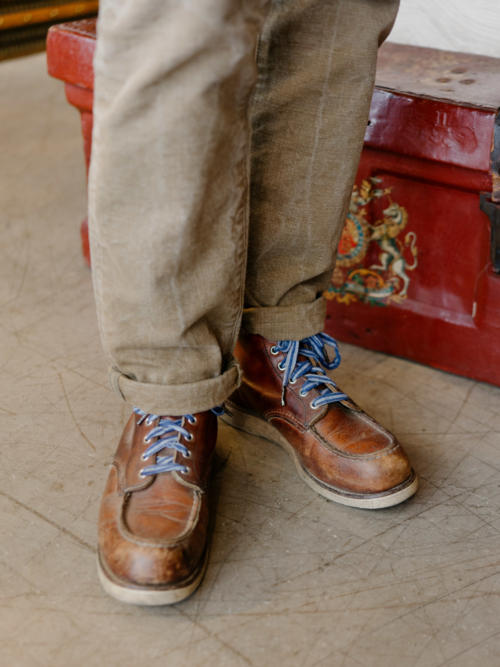
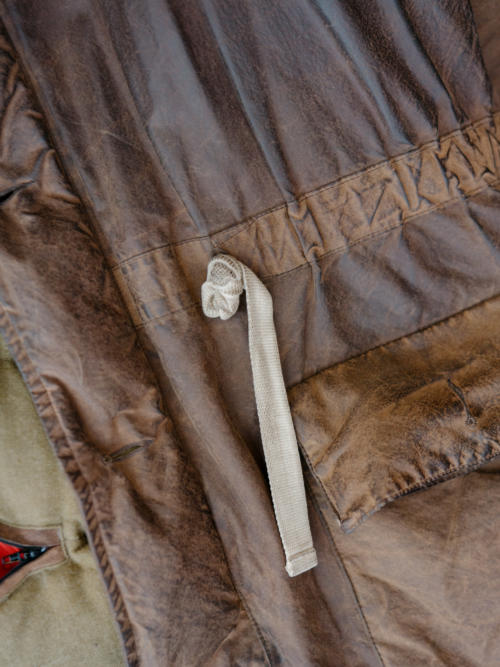


























Love Tim’s attitude to old things. He comes across as a very authentic guy who is comfortable in his own skin. What a lovely piece to start the day with, thank you Simon!
Another fabulous entry in this series. I particularly love the practical approach to clothing – Tim’s other half sewing in useful additions to fit in with Tim’s life and hobbies. Another way to make clothing distinctly one’s own. Thank you Tim and Simon!
This style is so difficult to pull off,but when it works it’s so quintessential British. I perticularly like the Oni Denim sulphur-dyed canvas and the green trainers. I do like the layered approach and splashes of colour. I can’t wait for autumn!
Tim – your look’s a world away from mine, but you wear it really well. Suits you down to the ground. Refreshingly different from #menswear.
I appreciate this series is about what readers wear, but please can you tell us what you are wearing in the photo at the end of the piece Simon? Thanks, Ben
Don’t worry Ben, it’ll be featured in a post soon…
Excellent, really like his style, a nice article. Shout out to Patagonia, if you didnt know they have a policy that they own all their clothing for life so it can always be returned, repaired or recycled, Patagonia has always been a leader in this.
Once again though, great article… thanks.
Hi Tim, Simon,
Another great contribution to this series and quite relatable to readers who tend to dress less formally. The Nigel Cabourn Parka looks amazing and all the better for probably being a one-off. Best wishes to your daughter for the future, she appears very skilled.
Cheers
P.s please keep these coming Simon.
Will do!
Thank you Stephen, I’ll pass tour best wishes on to her!
Excellent piece as always Simon. One question though, what’s the name of Tim’s shop?
Sorry, it’s Bentleys
Thanks. Quite well known actually!
Absolutely
Patagonia did the repairs for free !
I think it would be good to read an article about brands / manufacturers who do repairs and at what cost (or even free).
It would certainly help us understand and appreciate why certain brands charge more.
The brands themselves seem to keep quiet about possibly to avoid the free services being abused.
Having learnt about Patagonia from this article I’d certainly consider buying their stuff now.
I think most who make it as much of a part of their identity are pretty open about it. See Blackhorse Lane’s lifetime repair service as well
Arct’eryx have a similar policy to Patagonia and will either repair for free or replace for free in the product cannot be repaired.
Private White are also excellent at after sales repairs. Fixed a waxed cotton jacket pockets for me recently, wouldn’t countenance taking a payment.
I don’t get the difference in formality between the three outfits…agreed that everyone has their own style and utility for clothes, so why try to box them into a set pattern even if it doesn’t quite work?
Because I think it’s still an interesting framework Omar. Eg the point where Tim and I discuss what he thinks is the most appropriate for being in his shop – and the contrast with being out in the wild or fishing
I think the way a person thinks about and categorises clothes are an important part of personal style, and that many men today don’t really do this in terms of formality. The clothes I wear out to dinner are different from those that I wear to the office, but I couldn’t tell you which would be considered more formal (and probably wouldn’t care what the answer was in any event!).
Thanks Tom, yes that makes sense. Would the clothes you wore to either be different to the ones you wore doing nothing particular at the weekend? And if so how would you describe the difference? Smarter, rather than more formal?
Oh certainly I’d describe the clothes I wear at home on a weekend (jeans and a sweatshirt, maybe) as less formal than those I wear to the office/out for dinner – I’m not saying that the concept has no relevance!
I suppose that what I’m saying is that the point of these articles is to get an insight into how the subject goes about dressing for different occasions. But the most relevant dividing lines between different occasions might not be levels of formality, at least for many people. For example, I might wear chinos and an Oxford BD shirt to work, and grey flannels and a western shirt when out to dinner. I think both outfits are similar in formality. What’s driving the difference is that the dinner outfit is perhaps a bit more unusual, whereas the chinos and shirt fit in nicely at work.
Then again, as you say, formality levels does provide a consistent and ready made framework for this sort of article.
I see, yes that makes perfect sense Tom. Both might be similarly formal but more business or corporate – there are different dimensions to this other than just formality. The divisions we have seem to make sense for most people, but I can in particular that someone in an office environment might wear something rather different there. Thanks for brining it up.
Pitch your appearance to what you are doing. Quality and fit are constants,formality is a flexible concept.
Nicely put
A question for Tim, or anyone else who knows. In the second to last photo, the khakis have those odd white lines on them. Recently, I picked up a pair of old canvas pants with very similiar ones. Are they just a mark, left by someone pressing the crease too hard, or something else?
They’re a fading of the material and can be caused by a few things, including pressing a crease. Also, by leaving them folded or wrinkled after washing
HI Karol
it seems natural for heavy duck canvas; I have a few pairs owned from new and they have similar fade lines…. maybe creased during washing? but they have never been ironed/creased.
Hi Karol,
Well spotted. Simon is correct. These are the Oni Denim which are sulphur-dyed canvas. I spilt something on them and made the mistake of washing them. Even turned inside out, the washing machine took out the colour leaving those marks where the wet creases were.
I spoke to Son of a Stag in Spitalfields, afterwards and they explained what had happened. They did tell me though that they offer a specialist denim-wash service for just £10 which would have been perfect!
Great article/conversation, really interesting, thanks to Simon and Tim.
Great feature! I like the focus on vintage clothing style on the site (which I know you frequently feature shops that specialize) and in the fashion industry as a whole. Fast-fashion has gone haywire, and used/vintage clothing is a great way to combat that and ensure you won’t look like everyone else out there.
What a fabulous dresser and nice fellow. Your diverse profiles make me wish I had several lifetimes to develop a version of each of these wardrobes for myself.
Fabulous article. Consummate good taste but unique to him.
I like his style. I find that vest / waistcoat fascinating. Did he say it’s German?
No, that was the parka. I don’t think we know on the waistcoat
I completely agree with him on the Patagonia repair. It’s nice to see “technical” clothing being treated in this way; so much of this kind of clothing is not only utilitarian but disposable, and care/repair isn’t (or shouldn’t be) confined to “classic” sportswear in more traditional materials.
Well done Simon, again, for the quality of this series. Everyone in it has had their own deeply individual and well executed style that reflects who they are, what they do and where they spend their time; and all so different one to the next.
Cheers Jim, that’s been the aim throughout, pleased it comes across
I enjoyed that article. I believe I visited Tim’s shop on Walton St a few years ago though I know it has now moved. Lovely stuff in there and I can see the parallels between what he wears and what he sells.
Tim seems like a cool guy, and I think his style works very well for him given his line of business. But for regular people, that much vintage clothing might be an overkill. I am very much in support of maintaining good clothes for a long time, but I also believe the look shouldn’t be overly glorified – tbh that parka looks like that of a homeless person.
Btw, I checked the website of his store – really nice stuff, but I genuinely wonder who buys vintage leather trunks for more than 20k GBP. Is this a pure collectors thing?
Hey Felix,
Always good to have the alternative view, but consider you’re writing publicly about a person – nicer to say you think an aged wax parka like that looks too shabby or old for you, rather than making that comparison?
As to the prices at Bentleys, yes Tim specialises in the very best and often rarest.
S
Hi Felix,
The Cabourn parka is the most commented upon piece of clothing I’ve ever owned; “Where ever did you find that?”, “Is that an Everest?” etc but I have to say that your comment will forever be my favourite!
As far as the trunks go, the genuine answer is that they sell to a very broad cross-section of people. We sell to archives, museums, collectors and to people who just fall in love with them. Each one tells its own story.
All the best,
Tim
The mention about scarves and moths has reminded me I need to get one of mine repaired that got attacked by a moth right in the middle of it!
Is that the Tim of Bentley’s Antiques? I first read about the shop in Jeremy Hackett’s Mr. Classic.
It is indeed
Simon, you reader profiles are some of the most interesring posts here. It is because, ultimately, things are about people, not about themselves. People dress and through this dress try to express themselves: who they are, what they value, what they dream of becoming.
This reader of yours does the patinated, full-of-history look very well. I also very much like his choice of various shades of indigo. The grey-blue puffer has very beautiful colors.
There is an architect / philosopher Christopher Alexander – a cult figure in certain narrow circles, famous first and foremost for his book “A pattern language”. But besides that popular work, he also has a much deeper “Nature of Order”. In that book there is an interesting thought about various patterns, as well as natural textures (woods, stone, etc.) are beautiful. It is because they exhibit stimulating local symmetries aplenty.
I think about that idea when I look at Tim’s well-worn, faded, patinated clothes. I also think of the japanese concepts of wabi sabi and mono no aware (the pathos of things). Such clothes are not only beautiful, and rich in meaning (they tell stories – potentially, interesting ones), they also as if “ground” the wearer in some fundamental earthly way. Well-worn clothing, with natural textures and complex coloring make the wearer organically inscribed in the natural environment.
Lastly, there is that sociological interpretation of the value of patinated clothing: about how it signals old-money distinction, the history of ownership and the history wealth (the old country house look or whatever).
Thank you, that’s wonderfully put – I think I got two references out of five, so lots new to think about! Also nice to think about wabi sabi again
Hi AA, a fascinating, insightful and accurate observation.
Thank you for the book recommendation, I have ordered it.
Tim
AA, is that the same Christopher Alexander the prolific landscape painter? I seem to recall he was a great painter of the Kent countryside.
No, it is the architect and author of “A pattern language”
Ooh, I like this. Tim’s got an interesting eye and I would never look at those clothes on the rack or on a shelf and imagine you could get where he does with them. Even with such a perspective, the key elements that make style worth pursuing are there. I support this feature of PS!
Not related to this article, but: Do you know of any brands other than Stoffa who make knitwear in English rib?
No I don’t, but it’s the kind of style that comes around with RTW brands now and again
Lovely story. More interesting than the story of the “hat guy” in Charleston, South Carolina; rumour is that Cody Wellema is making a Johnny Depp-style hat for him. Hope to visit Tim’s shop one day. Cheers,
I had a different experience with Arct’eryx earlier this year. After a year, the jacket had a 5 cm tear in the seam on the sleeve, so I brought it to the Piccadilly store. It was then sent to Canada for repair. Thereafter I received an email saying tear couldn’t be repaired–I forget the reason, something like it was too old. They offered to return the jacket or give me voucher (something like 25% off next purchase.) I took the jacket back, bought repair tape and fixed myself. It seemed like a waste–sending jacket to Canada and back.
I thought it was particularly impressive with Patagonia that they had an English third-party repairer – though I’m sure they don’t have that in every country
Great article for the most interesting series of yours. Im not so much of a fan of this style but sure it is well thought and put together and reflect a lot Tims personality. By the way how do you choose the readers you interview ?
Thanks Georgios.
It’s usually readers I have met in person – so at events, at pop-ups, just in the street or through other contacts.
One of my most enjoyable reader profiles to date. Just loved Tim’s effortless ‘shabby chic’. I too mix a lot of vintage, second-hand with new clothes. Perhaps, what I have always struggled with is repairing items and great to see a lot of Tim’s go-to places for repairs here. You never disclosed the address of his luggage and travel accessories shop but I think I have walked past a shop that looks like it in Chelsea, west London.
Hey BB – yeah it’s in the comments above. Bentleys
Great story! I reuse or repair a lot of my families old ranch clothes! Its a great aesthetic, and I dont have to pay for a high quality jean shirt, when I have vintage made in the USA wrangler shirts ready to go!
Also, Patagonia is incredible. I had a down coat that had lost a lot of feathers in the arm. I was hoping for an awesome repair job, which they did not do. They swapped me for a brand new jacket free of charge. Would rather a repair, but still, they really stand behind their stuff.